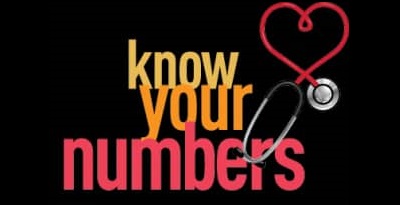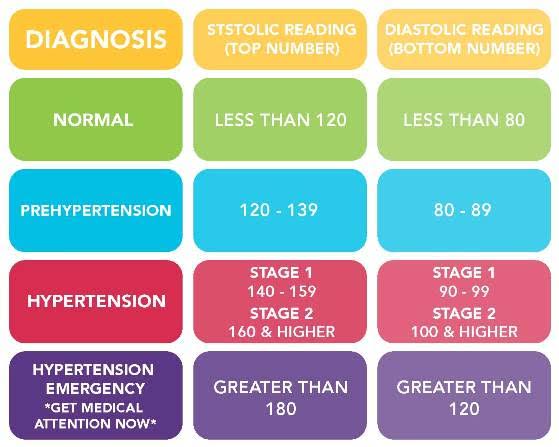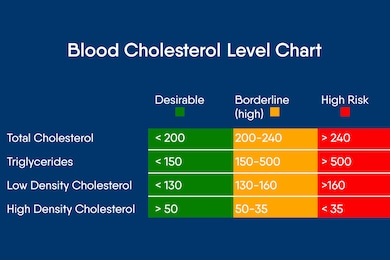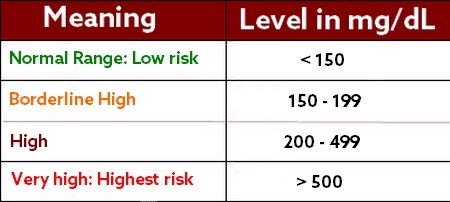
When it comes to your health there are a handful of numbers you need to know. That’s because certain numbers can tell you a lot about your risk for health hazards. Here are the numbers you need to focus on.
1. Blood Pressure

High blood pressure or hypertension is also called the silent killer because usually there are no symptoms attached to it. In severe cases the first symptom of hypertension may be a heart attack, stroke or even death. This number is composed of systolic and diastolic scores which correspond to the amount of pressure in your arteries during and in between heart beats.Normal blood pressure is below 120/80, the lower, the better. Prehypertension is 120/80 to 139/89Hypertension – 140/90 or higher
Have your BP checked by your doctor at least once a year – more often if you are at risk for heart issues.High blood pressure or hypertension is also called the silent killer because usually there are no symptoms attached to it. In severe cases the first symptom of hypertension may be a heart attack, stroke or even death. This number is composed of systolic and diastolic scores which correspond to the amount of pressure in your arteries during and in between heart beats.Normal blood pressure is below 120/80, the lower, the better.Prehypertension is 120/80 to 139/89Hypertension – 140/90 or higher
Have your BP checked by your doctor at least once a year – more often if you are at risk for heart issues.
2. Cholesterol

Cholesterol is a waxy substance produced by the liver. Cholesterol can’t dissolve in the blood so it has to be transported to and from the cells by carriers known as lipoproteins. The two main types are low-density lipoprotein (LDL) and high-density lipoprotein (HDL). Total cholesterol is composed by adding the two numbers together – LDL and HDL. The target is a total score below 200. Ideally the LDL or “bad” cholesterol should be below 100 and the HDL or “good” cholesterol should be above 40. In those ranges your risk for heart disease, a heart attack or other health issues is low. Have your cholesterol checked at least once a year, or more often if you are at risk for heart issues.
3. Triglycerides

Triglycerides are made from the fats and carbohydrates you eat, which are converted into a form that can be stored in fat cells. Triglycerides are also released from fat tissue when the body needs extra energy between meals. Its normal to have some triglycerides in your bloodstream, but high levels are linked to coronary artery disease. When you have high triglycerides paired with low HDLs, your risk of insulin resistance and metabolic syndrome may be increased.
- Normal triglycerides – less than 150mg/dl
- Borderline high – 150 to 199mg/dl
- High – 200 – 499mg/dl
- Very high – 500mg/dl or above
4. Blood Sugar

A blood sugar test measures the amount of glucose in your bloodstream. Usually the body tightly regulates the amount of glucose in the system. If this regulation breaks down, you are at risk for diabetes. Have your blood sugar checked annually.
- Normal fasting blood sugar is less than 100mg/dl
- Prediabetes – fasting blood sugar of 101 – 125mg/dl
- Diabetes – fasting blood sugar of 126mg/dl or greater on two or more occasions
5. Waist Size

Measure your waist size by wrapping a tape measure around your abdomen at the level of the belly button. Keep it snug but not tight and don’t pull your stomach in. Waist size is a better predictor of health than weight or BMI. Fat cells aren’t just for storage of calories. When your body fat is packed into your abdomen, the fat cells release inflammatory chemicals and abnormal levels of appetite-controlling proteins. If your waist size is above 35 inches for women or 40 for men, you are at increased risk for heart disease, diabetes, metabolic syndrome, high blood pressure and abnormal cholesterol.
Thanks For Reading
Don’t forget to subscribe to get the latest updates. If you have any questions or suggestions, leave a comment below or contact me here.



